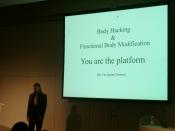The last decade has seen a dramatic rise in spectacular forms of body modification, including the tattoo renaissance and the phenomena of body piercing, the emergence of neo-tribal practices like scarification and the invention of new, high-tech forms of body art like sub-dermal implants. Therefore, body modification practices have proven to be an interesting field of study for sociologists interested in deviance, social control, and the social construction of problematic behaviour.
Much of the sociological research and literature into these practices fits within the symbolic interaction tradition, focusing specifically on the ways that people define body modification, and whether or not they perceive it as being scary or beautiful, dangerous or alluring, rebellious or inclusive. This essay explores the connections between body modification and deviance and seeks to identify whether physical alterations of the body are a rite of passage, a group identifier, or a mechanism of negative sanctioning and social control, believed to be key elements in the social construction of deviant self-identities.
The origins of the cultural trend of body modification, unlike those of nearly all other fads, are thousands of years old. Ever since our Neolithic ancestors invented art tens of thousands of years ago, humans have been decorating the human body, as it is the most intimate of canvas (Siebers 2000, p. 212). Most sociological theory about body modification is framed in discussions of labelling and differential association orientations which explain social definitions and the processes through which body modifiers learn how to be successful in changing the ways their bodies look to themselves, and to those with whom they come in contact.
The cause of controversy surrounding the issues of tattooing and piercings is directly rooted in the message that these forms of body modification present. The one essential feature all of...


